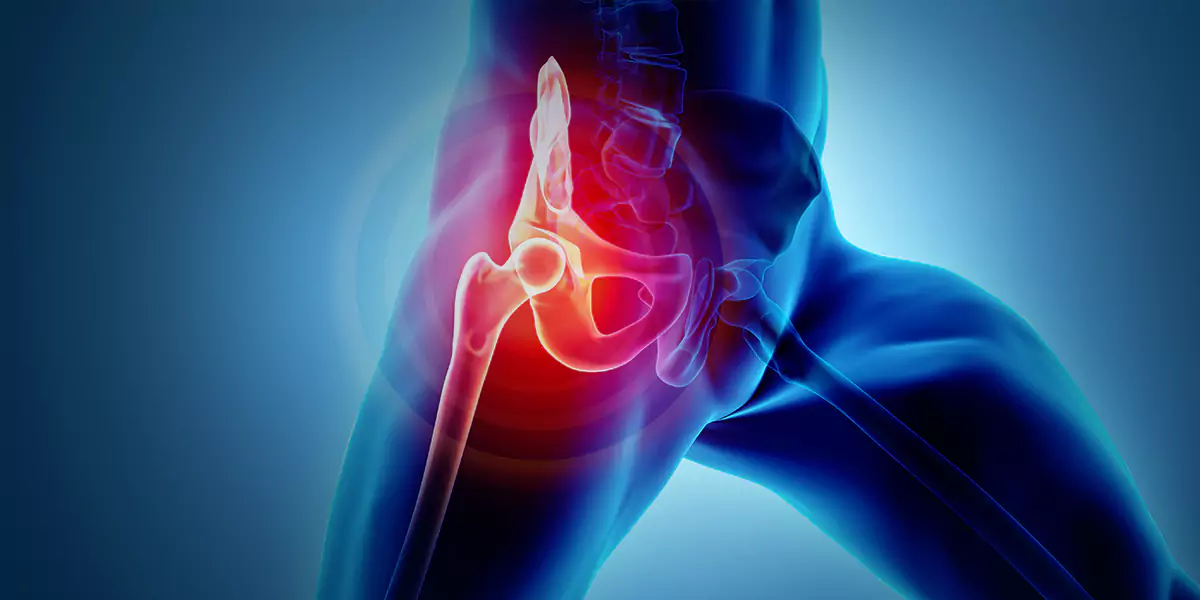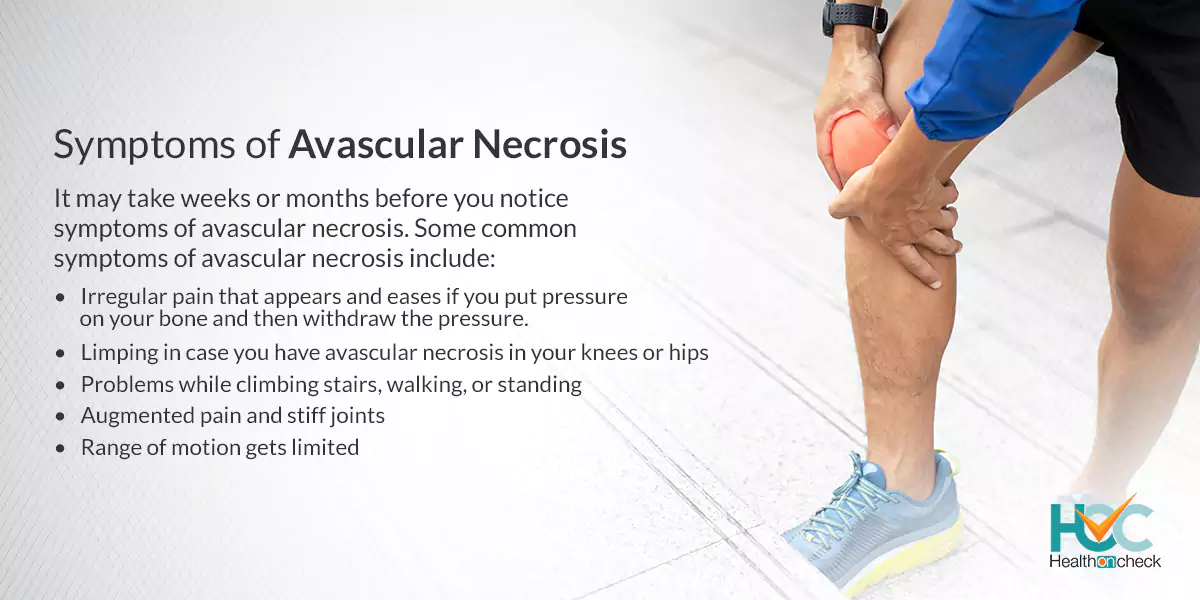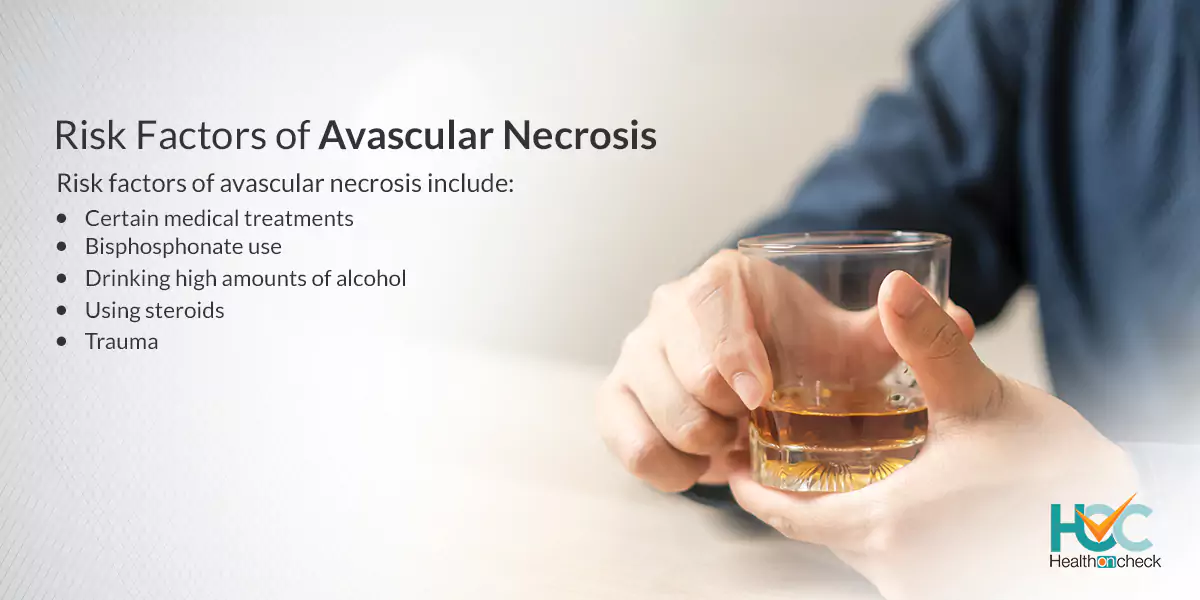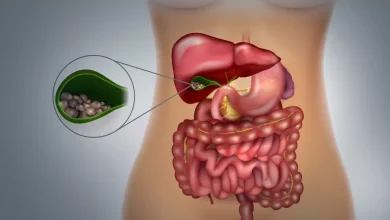What is Avascular Necrosis?

Avascular necrosis also known as osteonecrosis is the death of bone tissue because of the lack of blood supply which can lead to small breaks in the bone and result in bone collapsing. Blood carries the nutrients that oxygen bones require to regenerate and stay healthy. Without the flow of blood, the skeletal system is not able to make new bone tissue swiftly enough and the dying bone starts to crumble and ultimately collapses. A dislocated joint or broken bone could hinder the blood flow to a section of bone. Avascular necrosis is also linked with long-term use of high-dose steroid medications and drinking high amounts of alcohol for a long period. Anyone can get this condition but it’s more common in people between the ages of 30 and 50.
What are the Types of Avascular Necrosis?
The types of avascular necrosis include:
– Traumatic avascular necrosis
It occurs when you dislocate a joint or break a bone.
– Nontraumatic avascular necrosis
This type of avascular necrosis occurs when you have an illness or medical condition that stops blood from flowing to your bone tissue. Nontraumatic avascular necrosis usually affects the same bones on both sides of the body.
What are the Symptoms of Avascular Necrosis?
It may take weeks or months before you notice symptoms of avascular necrosis. Some common symptoms of avascular necrosis include:
– Irregular pain that appears and eases if you put pressure on your bone and then withdraw the pressure.
– Augmented pain and stiff joints.
– Range of motion gets limited.
– Limping in case you have avascular necrosis in your knees or hips.
– Problems while climbing stairs, walking, or standing.
What are the Causes of Avascular Necrosis?
Avascular necrosis is caused by bone fractures or complications that hinder blood flow to bone tissue. Nearly 20% of avascular necrosis cases occur without an apparent cause.
When the blood flow to a bone is interrupted or decreased, you might develop avascular necrosis. The causes of reduced blood supply might include:
– Bone or joint trauma
An injury, including a dislocated joint, might harm the nearby blood vessels. Cancer treatments that include radiation can also make bones weak and damage blood vessels.
-Fatty deposits in blood vessels
The fat (lipids) can obstruct small blood vessels and decrease blood flow to bones.
– Other health conditions
Medical conditions, like Gaucher’s disease and sickle cell anaemia, can also decrease blood flow to bone.
In some instances, the cause of avascular necrosis which is not because of trauma isn’t understood fully by researchers. Genetics in combination with overuse of alcohol, specific medications, and other diseases might play a role in triggering avascular necrosis.
What are the Risk Factors of Avascular Necrosis?
Risk factors of avascular necrosis include:
– Trauma
Injuries, like fractures or hip dislocation, might harm the adjacent blood vessels and decrease blood flow to bones.
– Using steroids
Using high-dose corticosteroids, including prednisone, is one of the common causes of avascular necrosis. The reason behind this is not yet known, but according to a few experts, the corticosteroids might increase lipid levels in the blood, and cause decreased blood flow.
– Drinking high amounts of alcohol
Drinking too much alcohol regularly for several years can result in fatty deposits forming in blood vessels.
– Bisphosphonate use
Using medications to increase bone density for a long time may contribute to developing osteonecrosis of the jaw. Though it’s a rare complication, it has happened in some people who are treated with high doses of these medications for cancers, like metastatic breast cancer and multiple myeloma.
– Certain medical treatments
Radiation therapy for cancer might make the bone weak. Organ transplants, generally kidney transplants, also are linked with avascular necrosis.
Medical conditions linked with avascular necrosis include:
– Pancreatitis
– HIV/AIDS
– Gaucher’s disease
– Systemic lupus erythematosus
– Sickle cell anaemia
– Decompression sickness
– Specific types of cancer, including leukaemia
What are the Complications of Avascular Necrosis?
Avascular necrosis if not treated can get worse and eventually, the bone might collapse. Avascular necrosis also results in the bone losing its smooth shape, causing severe arthritis.
How Avascular Necrosis is Diagnosed?
To diagnose avascular necrosis, at first, your doctor will carry out a physical exam, where they will press around your joints, and check the tenderness. After this, the doctor may move the joints through different positions to check if the range of motion is weak.
Imaging tests
Imaging tests can help to detect the source of pain. Tests might include:
– X-rays
X-rays help find the changes in bone occurring in the later stages of avascular necrosis. In the early stages of the condition, X-rays generally don’t show any problems.
– MRI and CT scan
Detailed images are created using these tests showing the early changes in bone that may indicate avascular necrosis.
– Bone scan
Here a tiny amount of radioactive material is injected into a vein which travels to the parts of bones that are either healing or injured. They are seen as bright spots on the imaging plate.
What are the Treatment Options Available for Avascular Necrosis?
The goal of treatment of avascular necrosis is usually to improve the joint, avert bone damage, and control pain. The best treatment is based on several factors, such as:
– Age
– Stage of the disease
– Location and amount of bone damage
– Cause
The treatment options for avascular necrosis usually include:
Medications
If the doctor is aware of what is causing your avascular necrosis, treatment will be done to manage it. It can include:
– Blood thinners
They are given if blood clots are causing your avascular necrosis.
– Nonsteroidal anti-inflammatory drugs (NSAIDs)
They help to ease the pain.
– Cholesterol drugs
They decrease the amount of cholesterol and fat in your blood, preventing the blockages that are causing avascular necrosis.
Surgery
Medications might slow down the process of avascular necrosis, but most of the people with this condition eventually require surgery. Surgical options include:
– Bone grafts
Here healthy bone from one part of the body is removed to replace the damaged bone.
– Osteotomy
It involves operating the bone and changing its alignment to reduce stress on the bone or joint.
– Total joint replacement
As the name suggests, here the damaged joint is removed and replaced with a synthetic joint.
– Core decompression
Here the part of the inside of the bone is removed to relieve pressure and permit new blood vessels to develop.
– Vascularized bone graft
Here your tissue is used to rebuild the damaged hip joints. The bone with the poor blood supply from the hip is removed by your surgeon who then replaces it with the blood-vessel-rich bone from another area, like the fibula, the smaller bone in your lower leg.
– Electrical stimulation
An electrical current can help to jump-start new bone growth. Your doctor might use it during surgery or provide you with a special gadget for it.
Living with Avascular Necrosis
Avascular necrosis is a painful disease that can significantly affect how you are leading your life along with affecting your ability to carry out daily chores. It also affects your performance at work or studies. You should discuss with your doctor if you have health complications or take medications that might increase your risk of developing avascular necrosis. Your doctor will give you detailed information about the symptoms of avascular necrosis. If you have any of these symptoms then you should get yourself diagnosed and start treatment accordingly.
Whom to Consult?
Avascular necrosis is a progressive condition that worsens over time. If you have avascular necrosis, you should regularly check your symptoms, like mobility and pain. You should call your doctor if you have pain that is not improving even after taking rest and pain relievers and also making walking or moving difficult or if you have an unexplained limping. You should also meet your doctor immediately if you have a possible broken bone or dislocated joint.






